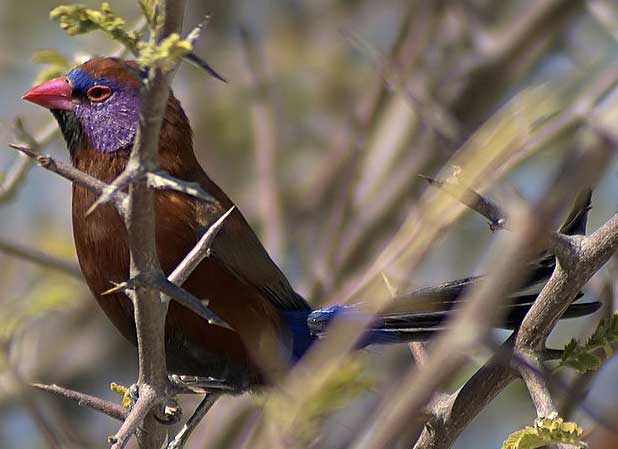
Uraeginthus granatina (*)
Superregnum: Eukaryota
Regnum: Animalia
Subregnum: Eumetazoa
Cladus: Bilateria
Cladus: Nephrozoa
Superphylum: Deuterostomia
Phylum: Chordata
Cladus: Craniata
Subphylum: Vertebrata
Infraphylum: Gnathostomata
Superclassis: Tetrapoda
Cladus: Reptiliomorpha
Cladus: Amniota
Classis: Reptilia
Cladus: Eureptilia
Cladus: Romeriida
Subclassis: Diapsida
Cladus: Sauria
Infraclassis: Archosauromorpha
Cladus: Crurotarsi
Divisio: Archosauria
Subsectio: Ornithodira
Subtaxon: Dinosauromorpha
Cladus: Dinosauria
Ordo: Saurischia
Cladus: Eusaurischia
Cladus: Theropoda
Cladus: Neotheropoda
Infraclassis: Aves
Ordo: Passeriformes
Subordo: Passeri
Infraordo: Passerida
Superfamilia: Passeroidea
Familia: Estrildidae
Genus: Uraeginthus
Species: Uraeginthus granatina
Subspecies: U. g. granatina - U. g. retusa - U. g. siccata
Name
Uraeginthus granatina (Linnaeus, 1766)
References
Syst. Nat.ed.12 p. 319
Vernacular names
čeština: motýlek granátový
The violet-eared waxbill or common grenadier (Granatina granatina) is a common species of estrildid finch found in drier land of Southern Africa.
Taxonomy
The violet-eared waxbill was formally described in 1766 by the Swedish naturalist Carl Linnaeus in the twelfth edition of his Systema Naturae under the binomial name Fringilla granatina.[2] Linnaeus took the specific epithet from the earlier description by the French zoologist Mathurin Jacques Brisson who in 1760 had used the French name Le Grenadin and the Latin Granatinus, meaning "genadier" in English.[3][4] Linnaeus mistakenly specified the locality as Brazil. This was an error originally introduced by the English naturalist George Edwards in 1743 who had believed that his specimen had come from Brazil.[5] The locality was amended to Angola by William Lutley Sclater in 1930 and restricted to Huíla Province in Angola by Phillip Clancey in 1959.[6][7][8] The violet-eared waxbill is now placed in the genus Granatina that was introduced in 1890 by the English ornithologist Richard Bowdler Sharpe.[9][10] The species is treated as monotypic: no subspecies are recognised.[10]
Habitat
Violet-eared waxbill at Etosha National Park, Namibia
It is found in subtropical/ tropical (lowland) dry shrubland and savanna habitats in Angola, Botswana, Mozambique, Namibia, South Africa, Zambia and Zimbabwe. The status of the species is evaluated as Least Concern.
References
BirdLife International (2016). "Granatina granatina". IUCN Red List of Threatened Species. 2016: e.T22719508A94630926. doi:10.2305/IUCN.UK.2016-3.RLTS.T22719508A94630926.en. Retrieved 12 November 2021.
Linnaeus, Carl (1766). Systema naturae : per regna tria natura, secundum classes, ordines, genera, species, cum characteribus, differentiis, synonymis, locis (in Latin). Volume 1, Part 1 (12th ed.). Holmiae (Stockholm): Laurentii Salvii. p. 319.
Brisson, Mathurin Jacques (1760). Ornithologie, ou, Méthode Contenant la Division des Oiseaux en Ordres, Sections, Genres, Especes & leurs Variétés (in French and Latin). Volume 3. Paris: Jean-Baptiste Bauche. pp. 216–218, Plate 9 fig. 3.
Jobling, James A. (2010). The Helm Dictionary of Scientific Bird Names. London: Christopher Helm. p. 177. ISBN 978-1-4081-2501-4.
Edwards, George (1743). A Natural History of Uncommon Birds. Part IV. London: Printed for the author at the College of Physicians. p. 191, Plate 191.
Sclater, William Lutley (1930). Systema Avium Aethiopicarum. Part 2. London: Taylor and Francis. p. 806.
Clancey, Phillip Alexander Clancey (1959). "Miscellaneous taxonomic notes on African birds XIV". Durban Museum Novitates. 5 (18): 231-259 [256].
Paynter, Raymond A. Jr, ed. (1968). Check-List of Birds of the World. Volume 14. Cambridge, Massachusetts: Museum of Comparative Zoology. p. 335.
Sharpe, R. Bowdler (1890). Catalogue of the Passeriformes or Perching Birds in the Collection of the British Museum. Sturnformes. Catalogue of the Birds in the British Museum. Volume 13. London: Trustees of the British Museum. p. 403.
Gill, Frank; Donsker, David; Rasmussen, Pamela, eds. (July 2021). "Waxbills, parrotfinches, munias, whydahs, Olive Warbler, accentors, pipits". IOC World Bird List Version 11.2. International Ornithologists' Union. Retrieved 16 July 2021.
BirdLife Species Factsheet
Retrieved from "http://en.wikipedia.org/"
All text is available under the terms of the GNU Free Documentation License

